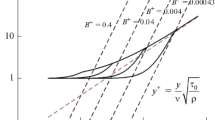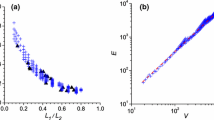Summary
A critical analysis is made of the assumptions underlying Reynolds' equations for turbulent flow. It is shown that there are regions in a flow field where these assumptions break down, and it is therefore necessary to separate the flow into a turbulent core and a laminar sublayer. The importance of the boundary conditions to be imposed on the mean velocities and Reynolds stresses at the junction is emphasized as this is the way in which the effect of surface roughness enters the theory. A set of equations for calculating turbulent flows is proposed. The distinctive feature is that the turbulent stresses are represented as the difference between viscous terms with a large eddy viscosity and terms satisfying auxiliary differential equations proposed by Broszko. These terms may be associated with the free and wall turbulence respectively. The theory enables the idea of a large eddy viscosity to be applied even where the velocity gradient is large. The results obtained for specific configurations, which will be reported in detail in future papers, are previewed.
Similar content being viewed by others
References
Reynolds, O., Phil Trans. A 186 (1895) 23.
Boussinesq, T. V., Mem. Pre. Par. Div. Sav. XXIII, Paris 1877.
Townsend, A. A., The Structure of Turbulent Shear Flow, Cambr. Un. Press 1956.
Goldstein, S., (editor), Modern Developments in Fluid Dynamics, Oxford 1938.
Dryden, H. L., NACA Tech. Note 1168, 1947.
Chou, P. Y., Quart. Appl. Math. 5 (1947) 346.
Rotta, J., Z. Phys. 129 (1951) 547; 131 (1951) 51.
Emmons, H., ASME Proc. 2nd U.S. Congress of Applied Mechanics 1954, p. 1–12.
Pai, S., Viscous Flow Theory II Turbulent Flow, Van Nostrand 1957.
Broszko, M., Ann. Acad. Polon. Sci Techniques 7 (1945) 75.
Broszko, M., Bull. Acad. Polen. Sciences et Lettres 1 (1951) 243.
Troskolanski, A. T., Hydromechanika Techniczna, Vol. I, Warsaw 1951.
Rosenfeld, L., Theory of Electrons, Interscience 1951, p. 15.
Elrod, H. G., J. Inst. Aero. Sci. 24 (1957) 468.
Izakson, A., Technical Physics of the USSR 4 (1937) 239 (n.b. this is not the J. Tech. Phys.).
Miller, B., Amer. Soc. Mech. Engrs 71 (1949) 357.
Rothfus, R. R. et al., Industr. Engng Chem. 42 (1950) 2511.
Squire, W., J. Inst. Aero. Sci. 18 (1951) 502.
Author information
Authors and Affiliations
Rights and permissions
About this article
Cite this article
Squire, W. A unified theory of turbulent flow. Appl. sci. Res. 8, 158–168 (1959). https://doi.org/10.1007/BF00411746
Received:
Issue Date:
DOI: https://doi.org/10.1007/BF00411746




